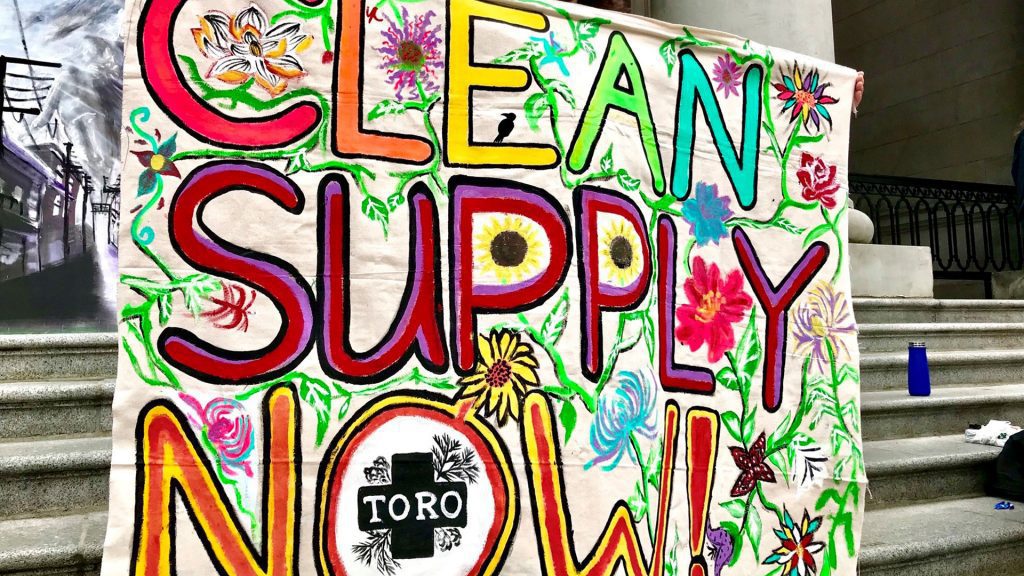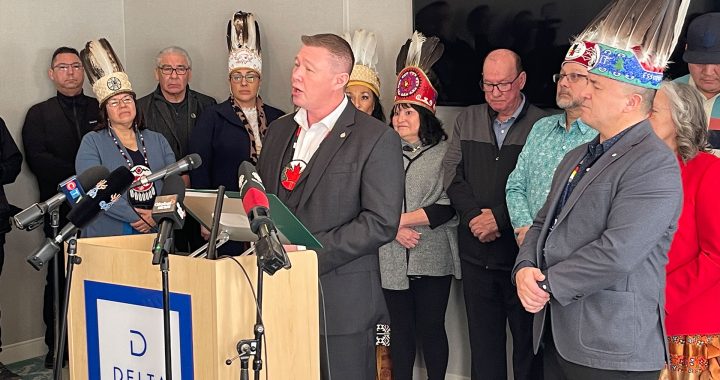
A poster on Vancouver's Downtown Eastside with a message for the government. Photo: Simon Charland/APTN.
British Columbia’s auditor general says two key government programs aimed at curbing the death toll from the toxic-drug crisis were not “effectively implemented” by the province’s health and mental health and addictions ministries.
Michael Pickup’s office released a separate report on the government’s supervised consumption services and the first phase of the prescribed safer-supply program, launched amid the crisis that has killed more than 14,000 people since a public-health emergency was declared in 2016.
The audit found the Health and Mental Health and Addictions ministries’ guidance didn’t include minimum service standards that ensured consistent quality and access of services, that it did not adequately respond to barriers such as local government resistance and that a new program evaluation was needed, given the evolving nature of the health emergency.
Pickup’s audit of safer supply found the ministries didn’t make “significant progress” in tackling its “most challenging barriers,” such as rural access to the program, health-care providers’ hesitancy about prescribing the drugs and whether the drugs being offered were appropriate.
Pickup said in a news release that the deficiencies have impacts on the people who need the services, their families and the health-care system.
The report says both ministries have accepted all seven recommendations from the reports, including improving minimum service standards, increasing public reporting and addressing a lack of doctors who can prescribe safer drugs.
“Many thousands of people in B.C. are grieving the losses of family and friends from the toxic-drug supply,” Pickup said. “The crisis is also an immense challenge for those working to provide care and support for people who use substances. My team and I have a deep sense of empathy for everyone who has been touched by this continuing tragedy.”
The report says overdose prevention and safe-consumption sites provide safer environments for people to use drugs under the supervision of a health-care professional or harm-reduction worker to monitor for signs of drug toxicity.
It found the ministries did not ensure provincewide implementation of those services to ensure consistency in the level and quality of care and said the ministry was “out of step with changes to the toxic drug supply.”
Pickup says overdose prevention and supervised consumption services are critical to saving lives and connecting people to the supports they need, but cited municipal resistance, location and accessibility of the sites and human resources as roadblocks to effective provincewide implementation.
The report says the safer supply prescription program is meant to generate evidence, and evaluation of that evidence will be “crucial to the program’s continuation.”
It says assessing the program’s success will require “high-quality evaluation data” because some clinicians are still skeptical due to lack of evidence and the program’s “politicization.”
The safer-supply program has generated criticism since its implementation, including from federal Conservative Leader Pierre Poilievre and Alberta Premier Danielle Smith, who both claimed that drugs from the program were being diverted into the rest of Canada.
The audit says the most common drug offered, hydromorphone, isn’t strong enough for fentanyl users and substances aren’t given out in “smokable form.”
The report says some service providers are “hesitant” about giving out prescriptions because of stigma and concerns over the drugs being diverted to the illegal market.
People on the program, the audit says, also fce restrictions about getting the drugs because they have to visit a pharmacy each day, and those in rural areas may lack access to “services required to safely and reliably access prescribed safer supply.”
The audit says anti-Indigenous racism and stigma against drug users also factors in, making access more difficult for those in need and limiting the number of health-care providers willing to dole out the drugs.
Solicitor General Mike Farnworth said last week that there’s no evidence of widespread diversion of the safe-supply drugs.
B.C. public health officer Dr. Bonnie Henry said in a report in December that there was a lack of evidence to determine if the problem was pervasive, although there were concerns from clinicians that the drugs were being diverted.
There are just under 50 overdose-prevention sites across the province and the BC Coroners Service says there has been one death in the province at a site this year.










